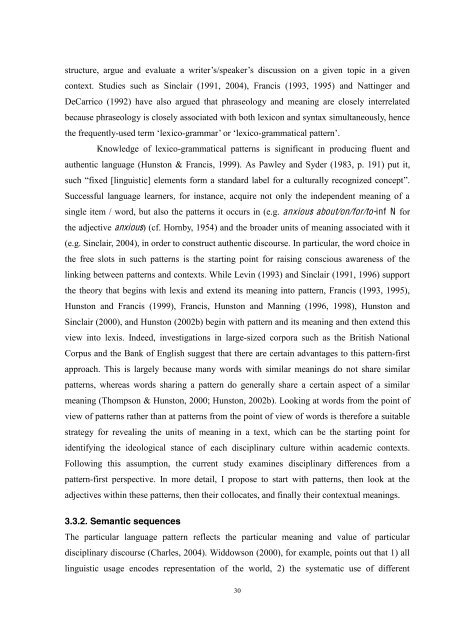Evaluative Meanings and Disciplinary Values - eTheses Repository ...
Evaluative Meanings and Disciplinary Values - eTheses Repository ...
Evaluative Meanings and Disciplinary Values - eTheses Repository ...
Create successful ePaper yourself
Turn your PDF publications into a flip-book with our unique Google optimized e-Paper software.
structure, argue <strong>and</strong> evaluate a writers/speakers discussion on a given topic in a given<br />
context. Studies such as Sinclair (1991, 2004), Francis (1993, 1995) <strong>and</strong> Nattinger <strong>and</strong><br />
DeCarrico (1992) have also argued that phraseology <strong>and</strong> meaning are closely interrelated<br />
because phraseology is closely associated with both lexicon <strong>and</strong> syntax simultaneously, hence<br />
the frequently-lexico-grammar or lexico-grammatical pattern.<br />
Knowledge of lexico-grammatical patterns is significant in producing fluent <strong>and</strong><br />
authentic language (Hunston & Francis, 1999). As Pawley <strong>and</strong> Syder (1983, p. 191) put it,<br />
such fixed [linguistic] elements form a st<strong>and</strong>ard label for a culturally recognized concept.<br />
Successful language learners, for instance, acquire not only the independent meaning of a<br />
single item / word, but also the patterns it occurs in (e.g. anxious about/on/for/to-inf N for<br />
the adjective anxious) (cf. Hornby, 1954) <strong>and</strong> the broader units of meaning associated with it<br />
(e.g. Sinclair, 2004), in order to construct authentic discourse. In particular, the word choice in<br />
the free slots in such patterns is the starting point for raising conscious awareness of the<br />
linking between patterns <strong>and</strong> contexts. While Levin (1993) <strong>and</strong> Sinclair (1991, 1996) support<br />
the theory that begins with lexis <strong>and</strong> extend its meaning into pattern, Francis (1993, 1995),<br />
Hunston <strong>and</strong> Francis (1999), Francis, Hunston <strong>and</strong> Manning (1996, 1998), Hunston <strong>and</strong><br />
Sinclair (2000), <strong>and</strong> Hunston (2002b) begin with pattern <strong>and</strong> its meaning <strong>and</strong> then extend this<br />
view into lexis. Indeed, investigations in large-sized corpora such as the British National<br />
Corpus <strong>and</strong> the Bank of English suggest that there are certain advantages to this pattern-first<br />
approach. This is largely because many words with similar meanings do not share similar<br />
patterns, whereas words sharing a pattern do generally share a certain aspect of a similar<br />
meaning (Thompson & Hunston, 2000; Hunston, 2002b). Looking at words from the point of<br />
view of patterns rather than at patterns from the point of view of words is therefore a suitable<br />
strategy for revealing the units of meaning in a text, which can be the starting point for<br />
identifying the ideological stance of each disciplinary culture within academic contexts.<br />
Following this assumption, the current study examines disciplinary differences from a<br />
pattern-first perspective. In more detail, I propose to start with patterns, then look at the<br />
adjectives within these patterns, then their collocates, <strong>and</strong> finally their contextual meanings.<br />
3.3.2. Semantic sequences<br />
The particular language pattern reflects the particular meaning <strong>and</strong> value of particular<br />
disciplinary discourse (Charles, 2004). Widdowson (2000), for example, points out that 1) all<br />
linguistic usage encodes representation of the world, 2) the systematic use of different<br />
30
















